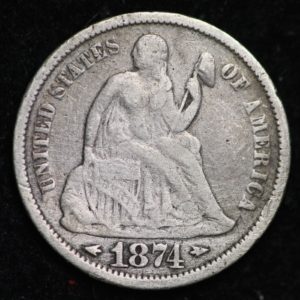Seated Liberty Dime
The Seated Liberty design was the standard in American coinage for decades, including dimes. Although it remained in circulation for more than 50 years, calls for its replacement came in the 1880s when it was nearing the half century mark. It first appeared in 1837, the end of Andrew Jackson’s  presidency, and lasted until 1891, the time of Benjamin Harrison’s presidency.
presidency, and lasted until 1891, the time of Benjamin Harrison’s presidency.
With more than 50 years in circulation, different varieties of the Seated Liberty dime were produced.
History of the Seated Liberty Dime
America in the 1830s hadn’t yet expanded the borders it occupies today. However, it had dreams of building an empire, but one grounded on democratic ideals.
Mint Director Robert Maskell Patterson, a Jackson appointee, long admired the seated figure of Britannia on English coins. He asked for a sketch of the goddess Liberty in a seated position. This was carried out initially by Chief Engraver William Kneass but continued by artists Thomas Sully and Titian Peale after Kneass suffered a stroke.
The design saw Liberty seated on a rock with the Union Shield that bears her name. The reverse featured the first use of the words ONE DIME in US coinage. The words were contained within a wreath and encircled by UNITED STATES OF AMERICA. This served as the basic design until modifications were made the following year.
Seated Liberty Dime Editions
Basic Design
More than 600,000 pieces of the 1837 version were issued, all featuring Large and Small Dates. There are also over 400,000 pieces made in New Orleans. The first edition Seated Liberty coin was also controversial for not featuring 13 stars, representing the states that made up the US back then, in its design. The issue was rectified with the 1838 release.
With Stars Obverse
In 1838, the US Mint issued a new design of the Seated Liberty piece – this time with 13 stars, a design that would last until 1860 with modifications in between.
A fold of drapery located at the crook of Liberty’s elbow started showing up in Seated Liberty dimes in the late 1840s. The design element was added to portray greater “respectability.”
There are about three dozen pieces belonging to the Stars Obverse Seated Liberty dime design. They are mostly collected by type rather than by date.
With Arrows
The California Gold Rush in the middle of the 19th century impacted US coinage leading the Mint to reduce the weight of silver coins. To help the public identify the new version, two arrowheads were placed in either side of the date. Seated Liberty Arrow dimes were issued in 1853 and lasted for three years.
Five date-and-mint combinations were produced from 1853 to 1855, with many collecting all five.
Another weight change in 1873 – this time an increase – saw the return of arrows on either side of the date. The design was discontinued in 1874, but the weight remained the same in the following years.
With “United States of America” Legend Obverse
With the public used to the lighter coins, the Mint removed the arrows in 1856 and issued versions with large and small dates. By 1860, the stars were removed from the obverse and replaced with UNITED STATES OF AMERICA. Since the legend was originally located on the reverse, the wreath was enlarged to compensate for its transfer.
More than 175 million Seated Liberty Legend Obverse dimes were produced from 1860 up to 1891. It was also produced at four mints: Philadelphia (didn’t feature a mintmark), New Orleans (O), Carson City (CC), and San Francisco (S).
This design is collected by date and mint or by type.
